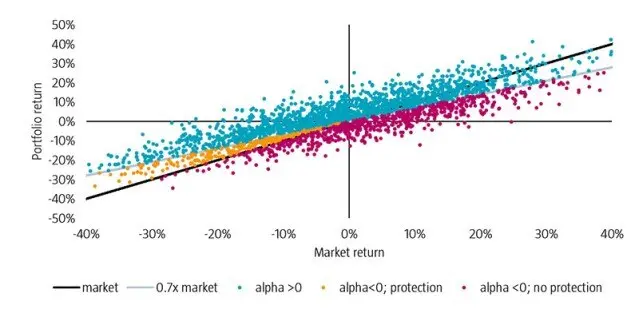Popular low volatility indices have significantly lagged their parent indices since the autumn of 2019. The recent woes for the factor can be explained by the fact that the market has been in ‘risk-on’ mode, i.e. riskier assets have fared better than safer ones.
“
In addition to being short exuberance, low volatility strategies are also short junk
Low Volatility is short exuberance and junk
Low volatility stocks tend to be mature firms with stable earnings and high dividends, which relates to the academic investment, profitability and value factors. Given these style characteristics, low volatility strategies generally tend to struggle during rallies of expensive risky stocks, with rapidly growing balance sheets and weak profitability.
While it is important for investors to be cognizant of this vulnerability of low volatility strategies, they should not interpret it as a fatal flaw, because the growth rallies in question are not supported by improving firm fundamentals. Instead, they are fueled by massive multiple expansion, which eventually tends to mean revert. Thus, low volatility strategies are short exuberance, and although this can cause significant underperformance in the short run, this positioning ultimately pays off in our view.
Low volatility strategies also tend to suffer when distressed stocks rebound. These so-called ‘junk rallies’ tend to be shorter-lived phenomena than the growth rallies discussed above, but share many similarities from a factor perspective. The stocks in question tend to involve high uncertainty, low dividends, a need for fresh capital and low profitability.
Therefore, in addition to being short exuberance, low volatility strategies are also short junk. These features help explain the major drawdowns of low volatility strategies, but also highlight the main risk that investors need to accept in order to harvest the low volatility premium in the long run.
クオンツ運用の価値を探求
最先端クオンツ戦略の情報やインサイトを定期的にお届けします。
Alpha volatility can momentarily cause aberrations
Many investors count on low volatility strategies to provide them with capital preservation during severe market downturns. But during the Covid-19-induced market crash in the first quarter of 2020, the downside protection they offered mostly fell short of expectations.1
Low volatility portfolios are characterized by a beta well below 1 and a positive expected alpha which reflects their long-term added value. However, the alpha does not come in a smooth, steady return stream, but involves a considerable amount of uncertainty. Using data from real-life low volatility strategies, we can estimate that the alpha is associated with a volatility of about 6% on an annualized basis.2
The effects of alpha volatility are illustrated in Figure 1 using a Monte Carlo simulation. The black diagonal line reflects the benchmark return and the grey line represents the expected return of a portfolio with a beta of 0.7 and no alpha. The dots depict 2,500 simulated portfolio returns assuming an expected alpha of 2% and taking into account the effects of 6% alpha volatility. The blue dots denote positive alphas, the orange dots negative alphas but with some downside protection, and the purple dots negative alphas with no downside protection.
Figure 1 | Simulated illustration of the impact of alpha volatility on Low Volatility performance

Source: Robeco Quantitative Research
Although low volatility strategies typically provide the expected protection during market downturns, there is always a non-negligible probability that they do not. The important thing, however, is that this does not invalidate low volatility investing, especially over the long run. This tail risk is inherently present in low volatility strategies. Without alpha volatility, low volatility investing would just be too good to be true, with a 100% downside protection rate accompanied by a positive alpha.
Figure 1 also helps to explain another counterintuitive result, specifically that low volatility strategies can outperform when the market delivers double-digit positive returns. Therefore, low volatility strategies cannot only surprise negatively, by underperforming in a down market, they can also surprise positively, by outperforming in an up market.3
Individual investor behavioral biases could strengthen Low Volatility anomaly
Investors tend to overpay for riskier stocks and underpay for safer ones.4 For professional investors, the key issue is that they are lured away from safer stocks towards riskier ones due to the pressure to beat benchmarks and peers. Individual investors appear to be attracted to risky stocks for different reasons, most notably their resemblance to lottery tickets.
For example, recent research examines the performance and trading behavior of investors using the commission-free Robinhood trading app.5 This study finds that these investors exhibit strong herding behavior, with a preference for buying risky, attention-grabbing stocks. This is clearly the kind of individual investor behavior that is related to the low volatility anomaly.
Exchange-traded funds (ETFs) is another innovation that has been massively embraced by individual investors. One study examines specialized ETFs that track niche portfolios and charge high fees. The researchers find that these products hold stocks with characteristics that are appealing to retail and sentiment-driven investors, such as high recent performance, media exposure and sentiment.6 This is again typical of the kind of behavior that supports the low volatility anomaly.
“
The recent rise of the retail investor is more likely to strengthen than to weaken the low volatility anomaly
At Robeco, we recently examined the low volatility effect in the local Chinese stock market, which offers a rare opportunity for what we believe to be a true independent out-of-sample test. Moreover, it is a market that is heavily dominated by individual investors. In our research, we uncover the presence of a strong low volatility effect in the Chinese A-share market.7
The recent rise of the retail investor is more likely to strengthen than to weaken the low volatility anomaly.
Thus, we believe the recent rise of the retail investor is more likely to strengthen than to weaken the low volatility anomaly, as these investors are particularly prone to the kind of behavioral biases which cause risky assets to become overpriced.
Low Volatility strategies can still deliver in prevalent interest rate environment
Numerous studies have established that low volatility stocks exhibit bond-like properties. So, falling interest rates provide some tailwinds, while rising rates tend to be a headwind.8 For 40 years, low volatility strategies were able to benefit from steadily decreasing rates. But now that they have reached zero, or even negative levels in numerous developed markets, can they still deliver in a world with structurally low rates, or if rates were to start rising again?
To assess the potential adverse impact of increasing rates, we take into account a 1994-like scenario. During this ‘annus horribilis’, 10-year Treasury yields rose by 200 basis points and average bond returns were about -10%. In our research, we estimated that low volatility stocks have a beta relative to bonds of about 0.3.9 In such a scenario, low volatility strategies would, therefore, take an expected hit of -3% (= -10% x 0.3).
Taken at face value, this is quite a sizable blow. However, compared to the regular alpha volatility of about 6% per annum, it is not particularly extreme. In other words, the impact of rate changes is essentially a second-order effect, that is typically overwhelmed by the influence of other factors – i.e. alpha volatility – on the performance of low volatility strategies at all times.
There is also the alternate, and arguably more likely, scenario that interest rates will remain low for many years. History suggests that low interest rates are not necessarily problematic for low volatility stocks. In one of our studies, we found that the volatility factor was able to deliver solid returns in the US during the 1940s and 1950s, when interest rates were structurally low.10
Altogether, we believe the case for low volatility has not weakened, but in fact strengthened.
Footnote
1 See: Mosselaar, J.S., 2021. “Dissecting the 2020 performance of low volatility indices.” Robeco article.
2 This estimate is based on long-term data for the Robeco Global Conservative Equities strategy and the MSCI World Minimum Volatility index, both in EUR.
3 See: Blitz, D., and van Vliet, P., 2014. “Low volatility investing: Expect the unexpected”, Robeco white paper. In this paper, we showed that low volatility investors should be prepared for this kind of unexpected outcomes using 85 years of historical data.
4 Blitz, D., Falkenstein, E., and van Vliet, P., 2014. “Explanations for the volatility effect: An overview based on the CAPM assumptions.” Journal of Portfolio Management 40(3), 61-76.
5 See: Barber, B., Huang, X., Odean, T., and Schwarz, C., 2020. “Attention induced trading and returns: Evidence from Robinhood users.” SSRN working paper, no. 3715077.
6 See: Ben-David, I., Franzoni, F., Kim, B., and Moussawi, R., 2021. “Competition for attention in the ETF space.” SSRN working paper, no. 3765063.
7 See: Blitz, D., Hanauer, M., and van Vliet, P., 2021. “The volatility effect in China” Journal of Asset Management, forthcoming.
8 See: Baker, M., and Wurgler, J., 2012. “Comovement and predictability relationships between bonds and the cross-section of stocks.” Review of Asset Pricing Studies 2(1), 57-87; De Franco, C., Monnier, B. and Rulik, K., 2017. “Interest rate exposure of volatility portfolios.” Journal of Index Investing 8(2), 53-67; and Blitz, D., 2020. “The risk-free asset implied by the market: Medium-term bonds instead of short-term bills.” Journal of Portfolio Management 46(8), 120-132.
9 Blitz, D., van der Grient, G., and van Vliet, P., 2014. “Interest rate risk in low volatility strategies”, Robeco white paper.
10 See: Blitz, D., van Vliet, P., and Baltussen, G., 2020. “The volatility effect revisited.” Journal of Portfolio Management 46(2), 45-63.
重要事項
当資料は情報提供を目的として、Robeco Institutional Asset Management B.V.が作成した英文資料、もしくはその英文資料をロベコ・ジャパン株式会社が翻訳したものです。資料中の個別の金融商品の売買の勧誘や推奨等を目的とするものではありません。記載された情報は十分信頼できるものであると考えておりますが、その正確性、完全性を保証するものではありません。意見や見通しはあくまで作成日における弊社の判断に基づくものであり、今後予告なしに変更されることがあります。運用状況、市場動向、意見等は、過去の一時点あるいは過去の一定期間についてのものであり、過去の実績は将来の運用成果を保証または示唆するものではありません。また、記載された投資方針・戦略等は全ての投資家の皆様に適合するとは限りません。当資料は法律、税務、会計面での助言の提供を意図するものではありません。 ご契約に際しては、必要に応じ専門家にご相談の上、最終的なご判断はお客様ご自身でなさるようお願い致します。 運用を行う資産の評価額は、組入有価証券等の価格、金融市場の相場や金利等の変動、及び組入有価証券の発行体の財務状況による信用力等の影響を受けて変動します。また、外貨建資産に投資する場合は為替変動の影響も受けます。運用によって生じた損益は、全て投資家の皆様に帰属します。したがって投資元本や一定の運用成果が保証されているものではなく、投資元本を上回る損失を被ることがあります。弊社が行う金融商品取引業に係る手数料または報酬は、締結される契約の種類や契約資産額により異なるため、当資料において記載せず別途ご提示させて頂く場合があります。具体的な手数料または報酬の金額・計算方法につきましては弊社担当者へお問合せください。 当資料及び記載されている情報、商品に関する権利は弊社に帰属します。したがって、弊社の書面による同意なくしてその全部もしくは一部を複製またはその他の方法で配布することはご遠慮ください。 商号等: ロベコ・ジャパン株式会社 金融商品取引業者 関東財務局長(金商)第2780号 加入協会: 一般社団法人 日本投資顧問業協会


















